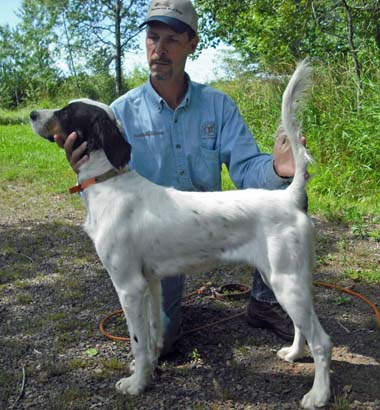Proper conformation
…the distinction between a good and bad specimen in the canine world is conformation.
~McDowell Lyon, The Dog In Action
Good conformation in a dog is highly valuable but essential for a working dog. It allows a bird dog to perform its job effortlessly and gracefully. It provides stamina for long periods of work. It endows the dog with durability for many years of service. Also conformation that is pleasing to the eye can be appreciated even when a dog isn’t working.
Two characteristics form the foundation of good conformation: balance and symmetry; angulation of the front and rear limb assemblies.
Balance and symmetry refer to a dog having proportional size and structure from front to rear, top to bottom and between the individual parts. Some examples of improper balance and symmetry are:
- heavy fronts combined with light rears (a common fault in setters)
- heavy bone without corresponding musculature
- overly large heads
- short necks
- long bodies with short legs
Correct angulation provides the propulsion for the dog which gives it strength, speed and stamina. These angles work like levers, multiplying the result for a given amount of effort. It is critical that both assemblies are angulated in unison and don’t work against each other. Examples of improper angulation include:
- straight shoulder blades which cause the front legs to hit the ground too hard
- straight rear legs which cause a reduction in drive and speed
- over-angulated rear legs that interfere with the front legs when in motion, also called crabbing

Northwoods Parmigiano displays good shoulder angulation and balance between front and rear assemblies.
A well-performing dog is the result of good conformation.
~ Robert G. Wehle
At Northwoods Bird Dogs, Betsy and I apply a singular conformation standard to both our pointers and setters. We adopted it from legendary pointer breeder Robert Wehle.
These are the details we look for:
- square, balanced head
- long neck and smooth shoulders with angular blades that are well laid back
- feet should be tight with the dog standing well up on the pad
- front legs should be straight with a medium-deep chest (as opposed to wide)
- back should be slightly arched and have strong, developed loins
- well-tucked stomach
- well-angulated hind legs
- hind quarters should be square and straight
- tail should be set and carried high
For more information about conformation and locomotion in dogs, read McDowell Lyon’s excellent book, The Dog In Action.






